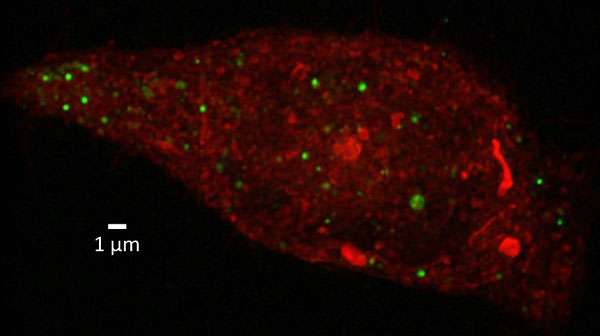Super-resolution image showing exosomes (green) within a cultured kidney cell (red)
Researchers from the National Physical Laboratory (NPL) and MedImmune, the global biologics research and development arm of AstraZeneca, are collaborating to investigate the use of exosomes for the targeted delivery of therapeutics.
Exosomes are small (30 – 100 nm) vesicles that transfer biologically active molecules, such as proteins and RNA, between cells. They hold great promise as a delivery mechanism for molecules used to treat a wide range of diseases, however, a lack of understanding about how exosomes are taken up by cells currently limits their therapeutic use.
Their small size makes exosomes difficult to image using conventional optical microscopy. To overcome this, the NPL team is using a custom-built super-resolution structured illumination microscopy (SIM) system to investigate the binding and trafficking of exosomes across cell membranes. By illuminating the sample with a sequence of light patterns, SIM allows time-lapse imaging of live cells with spatial resolution down to 100 nm. In one early experiment, the researchers were able to watch a single exosome migrate across the membrane of a kidney cell in real time.
Mike Shaw, a senior research scientist from NPL's Biotechnology Group, said: "This is a very exciting application of structured illumination microscopy. As a fast, minimally-invasive imaging technique, SIM is ideal for observing these kinds of dynamic processes."
Natalie Tigue, a senior scientist from the Antibody Discovery and Protein Engineering group at MedImmune, said: "The knowledge gained through the visualisation of exosome uptake and trafficking at the resolution afforded by SIM will inevitably lead to strategies for generating more selective or targeted exosomes. This will be an important step in the development of exosomes as carriers for the delivery of important therapeutic molecules."
Provided by National Physical Laboratory





















